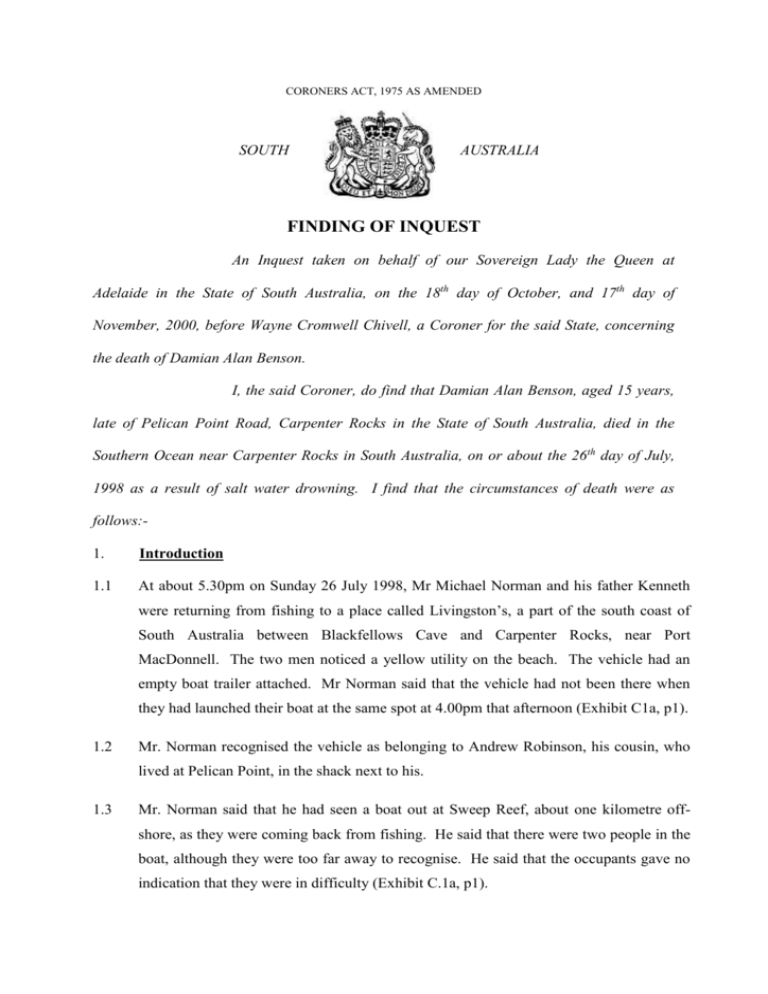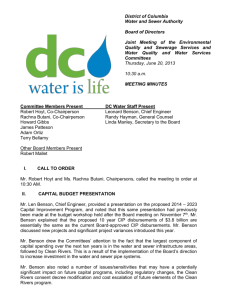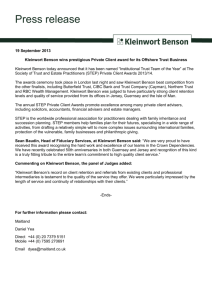BENSON Damien Alan
advertisement

CORONERS ACT, 1975 AS AMENDED SOUTH AUSTRALIA FINDING OF INQUEST An Inquest taken on behalf of our Sovereign Lady the Queen at Adelaide in the State of South Australia, on the 18th day of October, and 17th day of November, 2000, before Wayne Cromwell Chivell, a Coroner for the said State, concerning the death of Damian Alan Benson. I, the said Coroner, do find that Damian Alan Benson, aged 15 years, late of Pelican Point Road, Carpenter Rocks in the State of South Australia, died in the Southern Ocean near Carpenter Rocks in South Australia, on or about the 26th day of July, 1998 as a result of salt water drowning. I find that the circumstances of death were as follows:1. Introduction 1.1 At about 5.30pm on Sunday 26 July 1998, Mr Michael Norman and his father Kenneth were returning from fishing to a place called Livingston’s, a part of the south coast of South Australia between Blackfellows Cave and Carpenter Rocks, near Port MacDonnell. The two men noticed a yellow utility on the beach. The vehicle had an empty boat trailer attached. Mr Norman said that the vehicle had not been there when they had launched their boat at the same spot at 4.00pm that afternoon (Exhibit C1a, p1). 1.2 Mr. Norman recognised the vehicle as belonging to Andrew Robinson, his cousin, who lived at Pelican Point, in the shack next to his. 1.3 Mr. Norman said that he had seen a boat out at Sweep Reef, about one kilometre offshore, as they were coming back from fishing. He said that there were two people in the boat, although they were too far away to recognise. He said that the occupants gave no indication that they were in difficulty (Exhibit C.1a, p1). 2 1.4 Mr. Norman knew that Mr. Robinson was away in Queensland at the time, and that Christopher Benson and his son Damian were living in his shack. Mr. Benson was the deck-hand on Mr. Robinson’s crayfish boat. Mr. Norman said:“I had seen Chris working on the dinghy earlier in the day. He had bought a new transducer for the sounder and was fitting it to the rear of the boat. That was at about 1 or 2 o’clock. I spoke to him at the time but he did not actually say that he was going out to have a fish. He said the snapper were going, and I presume he was going to go and have a go at them because he was fixing the boat”. (Exhibit C.1a, p1-2). 1.5 Mr. Norman telephoned Mr. Benson at between 6.00p.m. and 7.00p.m. that evening, but he received no answer. He said that he left a message on the answering machine. 1.6 When Mr. Norman returned to his shack from Mount Gambier at about 11.30a.m. on Monday 27 July 1998 he noticed that the Hi-Lux utility and the dinghy were still not there. He then went back to Livingston’s and found the vehicle and trailer in the same spot it had been the afternoon before, standing in about 15cm of water from the incoming tide. 1.7 Mr. Norman arranged for the vehicle to be moved to dry ground, and then he and his father launched their dinghy and searched for an hour or so, but found nothing. He said:“The weather at this time was good, you wouldn’t get any better at this time of year. The sea was flat and there was only a bit of a break on the reefs”. (Exhibit C.1a, p2). 1.8 When they returned from their search, Mr. Norman contacted the police. 2. The search 2.1 Senior Constable A.M. McClean of Port MacDonnell Police Station proceeded to Livingston’s Landing, arriving about 2.55p.m. He spoke to Mr. Norman, who passed on the information he had. As to the commencement of the search, Senior Constable McClean said:“When first being made aware of this incident, the local emergency plans were swung into operation. A short time after I arrived at Livingstons Landing, a State Emergency Service crew arrived. I liaised with them and they commenced a search of the shoreline in the area. The weather at this time was still good, with a slight breeze, calm seas and overcast skies. A storm warning had been issued for the coastal area and a front could be seen approaching the area from the west. 3 I was informed that an air search had been commenced from Mount Gambier airport using local aircraft. Using radio equipment from the S.E.S. we were able to have contact with the search plane in the area, but they were also unable to spot anything. The skies continued to darken and the front arrived in the area in an offshore direction. It became extremely dark and we were unable to see the aircraft until it flew out of the frontal cloud. We were advised that visibility offshore was severely hampered by the arrival of the front and nothing had been sighted. The search was called off for the day at approximately 6.00p.m. due to darkness and deteriorating weather conditions”. (Exhibit C.21a, p2). 2.2 The search recommenced at about 8.45a.m. on Tuesday 28 July 1998. Australian Search and Rescue (AusSAR) in Canberra had taken control of the sea search. Senior Constable McClean said:‘The weather had deteriorated further overnight, with strong winds and rough seas continuing for several days. The current in the area runs in an easterly direction at a speed of between one and two knots. It was predicted that due to the current and past experiences in the area that if anything from the dinghy was to wash ashore it would be east of where they were last sighted, and if anything was floating it would most probably wash ashore in the Cape Bridgewater area near Portland, Victoria. Localised shore searches were conducted between Blackfellows Caves in the west to Cape Douglas in the east. Nothing was located as a result of these searches’. (Exhibit C21a, p2) 2.3 The search involved SA Police, the State Emergency Service, the Country Fire Service, AusSAR, and Victoria Police. 2.4 Further enquiries were also made in relation to the condition of the dinghy, the experience of Mr. Benson, and his knowledge of the area. 2.5 On Wednesday 29 July 1998 Mr. Gregory Von Stanke found a yellow plastic “Magnum” brand fishing tackle box full of new fishing gear at Livingstons Bay. About twenty feet further away, he also found a section of rubber deck matting (see Exhibit C.15a, p1). 2.6 Later that afternoon, Senior Constable McClean with Superintendent Bristow and Sergeant McFarlane of Mount Gambier Police travelled to Portland, Victoria, where they took possession of a red plastic “Quick Silver” outboard motor fuel tank which had been located near Cape Bridgewater. He was also informed that a life-jacket had been sighted but could not be retrieved due to the rough weather (Exhibit C21a, p5). 2.7 The tackle box, deck mat, and fuel tank were all identified by Andrew Robinson as coming from the dinghy (see Exhibit C.10a, p5). Matthew Lund, a young man who knew Damian Benson, also identified the fuel tank and tackle box, together with a towel 4 produced by Mr. McClean, and a pair of sunglasses which he believed may have been Christopher Benson’s (see Exhibit C.11a, p2). 2.8 On Thursday 13 August 1998, three of Mr Christopher Benson’s brothers, James, Gary and Ronald, were walking along the shore near Blackfellows Caves, when Gary Benson found a black Silstar fishing rod and reel at the water’s edge. This was identified by James Benson as being ‘identical’ to a rod owned by Christopher Benson (Exhibit C4a). 2.9 As the brothers were walking back up to the high water mark, James Benson saw some bones tangled up in the seaweed. Upon further inspection, this appeared to be a human skeleton. Gary and Ronald Benson went to call the police and, while he was waiting, James Benson continued to search, and found a white-peaked baseball-style cap with “Sydney” logo on the front, and also the peak from a black cap (Exhibit C4a, p1). 2.10 The police were called and the skeleton was retrieved and found to be complete except for the head, one arm, both hands and both feet. 2.11 These remains were examined by Dr. R.A. James, Forensic Pathologist, at the Forensic Science Centre on 18 August 1998. Dr. James expressed the opinion that the deceased person was estimated to be 175cm (+ or - 3cm) in height, white, and the appearance suggested that the person had been dead for several weeks, and were consistent with death on or about 26 July 1998. The bones were obviously male, the person was of solid build, and Dr. James estimated his age as being in the late 30’s (Exhibit C.22a). Professor Maciej Henneberg, the Head of the Department of Anatomical Sciences at the University of Adelaide, also examined the remains, and his opinion was similar to that of Dr. James. He found that the skeleton was that of a male, in his late 30’s (+ or - 5 years), 1.75 metres in height, and right-handed (see Exhibit C.23b). 2.12 The discovery of these remains prompted a renewed search. On 14 August 1998 a close and detailed search of the foreshore at Blackfellows Cave was conducted. Further bones were located, as well as a second black fishing rod and reel. 2.13 The search continued on Saturday 15 August 1998, involving S.E.S. volunteers, along extensive stretches of the coastline. Nothing further has been located. 2.14 The Police Water Response Section had conducted an underwater search between Sunday 2 August 1998 and Tuesday 4 August 1998, although this had been interrupted 5 due to bad weather. They returned on 16 August 1998 and conducted extensive searches between the Sweep Reef area and the point where the skeletal remains were found, but did not locate anything of interest statement of Senior Constable Syrus, Exhibit C18a). 2.15 On Saturday 29 August 1998 Ms. Nicole Lovelock was walking along the beach at Pelican Point, when she found a piece of a human skull about two metres from the shoreline in about 15cm of water. This was reported to the police. 2.16 The skull fragment was examined by Dr. James and Professor Henneberg. Professor Henneberg estimated the age of the person as from the late 30’s to early 40’s, and probably male. 2.17 Having regard to the totality of the evidence, the human remains discovered are consistent with the description of Christopher Alan Benson. On the basis of this evidence, on 2 December 1998 I made a finding pursuant to Section 31A of the Coroners Act concerning the death of Christopher Alan Benson. 3. Background 3.1 Damian Alan Benson was born on 17 May 1983. His parents separated in 1989, and his mother moved to Sydney, taking him and his sister with her. Since that time the children visited their father regularly during school holidays. 3.2 Damian stayed with his father at Carpenter Rocks for the Christmas holidays in 1997/98, and then decided to stay there with his father. His mother, Mrs. K.E. McCallum, said:“Chris and Damian have always been mad on fishing”. (Exhibit C.3a, p2). She added that Mr. Benson was experienced and competent in handling a boat. 3.3 Senior Constable McClean conducted enquiries into the family situation, and his statement reads:“Christopher Benson had been visiting the area for several years and was well respected and liked by the local community. He had taken up permanent residency during the preceding year when he had gained employment as a deckhand on a commercial rock lobster fishing boat. It is not clear what general knowledge had had of the inshore reefs in the area. From information received he was a competent fisherman who was trusted with control of the dinghy to go fishing, but the area is dotted with reefs and rocky outcrops. The seas in the area are unpredictable, and freak waves are not uncommon among the reef areas. 6 Damian Benson had been separated from his father for a long period of time due to the breakdown of the relationship between his parents. He had resided in Sydney with his mother and visited the area regularly on school holidays. He had left his mother’s home approximately six to eight months before this incident to live with his father. He was well liked by the local community, and shared a love of fishing and the sea with his father, with them both regularly fishing together”. (Exhibit C.21a, p3). 4. Events of the day 4.1 Mr. Clive Westbrook, the proprietor of the Carpenter Rocks Caravan Park, said that he had seen Christopher and Damian Benson at about 3.30p.m. on Sunday 26 July 1998. They purchased some bait. Mr. Benson told Mr. Westbrook’s wife that he had fixed the engine on the boat, and that he and his son were going out fishing. Mr. Westbrook saw the Hi-Lux utility, towing the boat, parked outside his shop. He noticed that Damian was wearing a white baseball cap (Exhibit C.8a, p2). 4.2 At about 4.00p.m. that day, Ms. Wendy Devereux spoke to Mr. Benson on the telephone. Ms. Devereux was Christopher Benson’s sister-in-law and Damian’s aunt. Mr. Benson told her that he and Damian were going out fishing. She said that he seemed “happy and cheerful” and that the weather was “perfect” (Exhibit C.12a, p1). 4.3 On the basis of this evidence, there is no doubt that Mr. Benson and his son went fishing, and it seems likely that it was them who were seen by Michael Norman and his father later that afternoon in the vicinity of Sweep Reef. 4.4 I am satisfied on the evidence that neither Christopher Benson, nor his son Damian, have been seen or heard from since. 5. Condition of the dinghy 5.1 Mr. Andrew Robinson, the owner of the dinghy, says that he bought the dinghy secondhand, and he estimates that it would have been between 25 to 30 years old. It was 3.9 metres long and had been used for many years as a tender by a professional fisherman. The seats were filled with foam for buoyancy, but the forward seat had been removed. This would have reduced the buoyancy of the dinghy if it had overturned. The condition of the foam in the other two seats is unknown. The aluminium in the dinghy had split in several places and been repaired by welding. It was also patched to cover a hole, and there were other pin-hole leaks which had been repaired. The plate at the stern where the outboard motor is attached was cracked (Exhibit C.10a). 7 5.2 Mr. Robinson said that he had purchased the 15 horsepower Mercury outboard motor five or six years earlier. It had been serviced several times, the last being on 25 February 1998. Mr. Ian Ploenges, a marine technician, repaired the motor by replacing the propeller shaft and propeller. He also gave it a standard tune-up and service and replaced two spark plugs and the starter rope. He said that the motor was in “good working order” when it was collected by Mr. Robinson (Exhibit C.14a). 5.3 Mr. Robinson said that the motor was sometimes difficult to start, although after it had been running for awhile, this condition improved (Exhibit C.10a, p3). 6. Conclusions 6.1 Having conducted an inquest into the disappearance of Damian Alan Benson, I am satisfied on the balance of probabilities that he met the same fate as his father, even though his body has never been found. 6.2 I agree with the opinion expressed by Senior Constable McClean at the conclusion of his report:“At the time of submission of this report there have been no further discoveries of property or remains in the Blackfellows Caves area that may be attributable to this accident. It is the opinion of the investigating officer that Christopher Alan Benson and Damian Alan Benson died in the waters off Blackfellows Caves, South Australia, on or about Sunday 26 July 1998, drowning as the result of a boating mishap”. (Exhibit C.21a, p11). Key Words: boating accident; drowning; disappearance In witness whereof the said Coroner has hereunto set and subscribed his hand and Seal the 17th day of November, 2000. Inq.No.37/2000 ……………………………..……… Coroner









